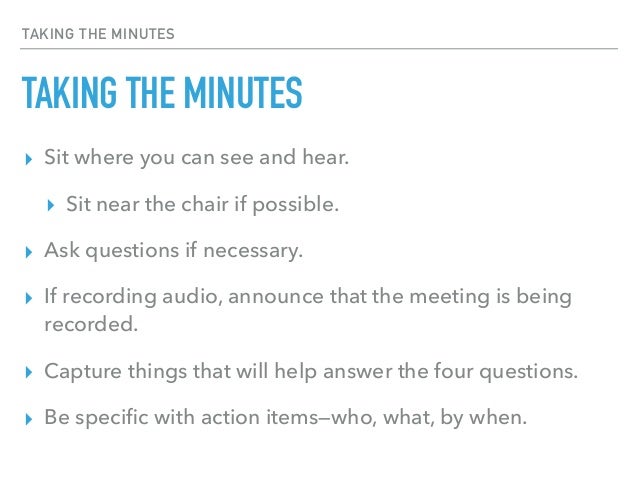

TAKE THE MINUTES FULL
TAKE THE MINUTES HOW TO
Your organization may also require the president’s signature.Īs part of knowing how to take minutes for a board meeting, you should always follow your organization’s by-laws and protocols for storing minutes. Once your meeting minutes are fully written, you are responsible for making them official by having the board secretary sign them. Step 4: Signing, Filing, and Sharing Minutes It’s better to attach meeting handouts and documents that were referred to during the meeting to the final copy, rather than summarizing the contents in the minutes.

Edit the record so that the minutes are succinct, clear, and easy to read. Review actions, motions, votes, and decisions for clarity. Review the agenda to gain the full scope of the meeting. Step 3: Writing the Official Record of Board Meeting Minutes Use names only when recording motions and seconds.Īfter the meeting, you will want to write the formal record when everything is still fresh in your mind, so prepare the record as soon after the meeting as you possibly can. Boards have legal liability, so keep information basic and language simple to avoid any legal complications that place the organization at a disadvantage in any legal proceedings. Document board discussions to accurately reflect the actions and intentions of the board directors. In a legal arena, meeting minutes are presumed to be correct and can be used as legal evidence of the facts they report. Check your language to be sure that it is clear, unambiguous, and complete.Īs noted earlier, minutes are an official and legal record of the board meeting. A good way to do this is by avoiding adjectives and adverbs whenever possible. Record discussions objectively, avoiding inflammatory remarks and personal observations. If there are extensive arguments, write a succinct summary of the major arguments. For each agenda item, write a short statement of each action taken by the board, along with a brief explanation of the rationale for their decision. How you detail the discussions during a board meeting is as important as making sure to include all of the information in the bullets shown above.

Ask the board president for a copy of the meeting agenda, including the names of all attendees, including guests or speakers. Review past meeting minutes to use as a template. Have a discussion with the board president about any current or expected formats that you are expected to use. In learning how to take meeting minutes for a board meeting, it’s important to note that every organization records their minutes a little bit differently.

Step 1: Preparation for the Board Meeting You’ll also be responsible for filing and sharing the minutes of each meeting. You’ll need to spend a little time planning before the meeting, take notes during the meeting, and write a formal report after the meeting. In your role as secretary, you’ll essentially have four steps involved with recording effective minutes for a meeting. Taking Minutes for a Board Meeting – Step by Step Among other things, your meeting minutes should reflect a record of motions, votes, and abstentions. Minutes are used in a variety of ways including tracking progress, detailing future plans, and serving as a reference point. Board meeting minutes are more than a general accounting of board discussions they serve as an official and legal record of the meeting of the Board of Directors. Taking good meeting minutes at a board meeting is an important and fulfilling role.


 0 kommentar(er)
0 kommentar(er)
